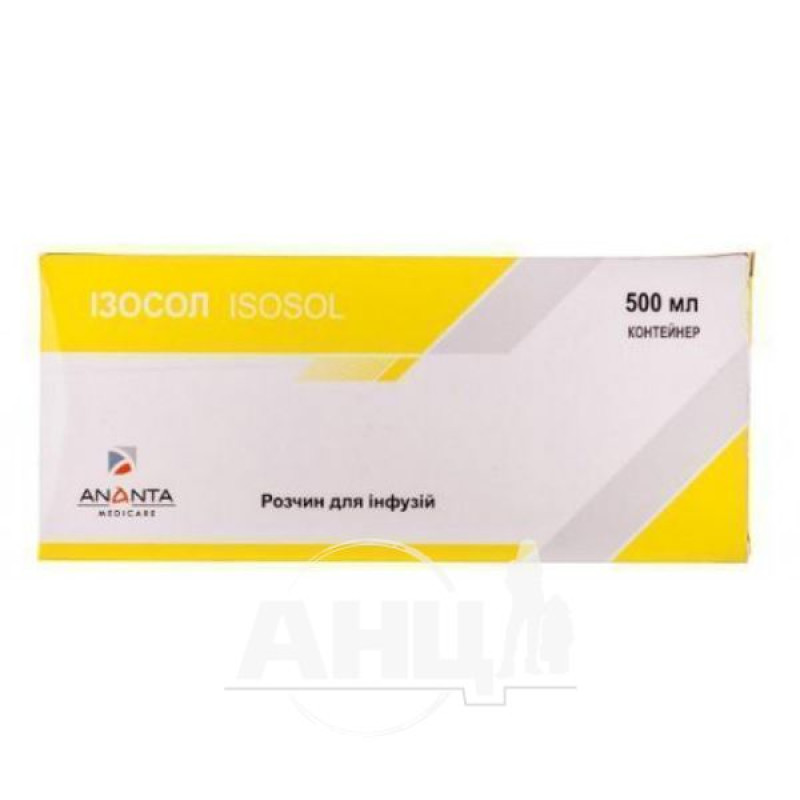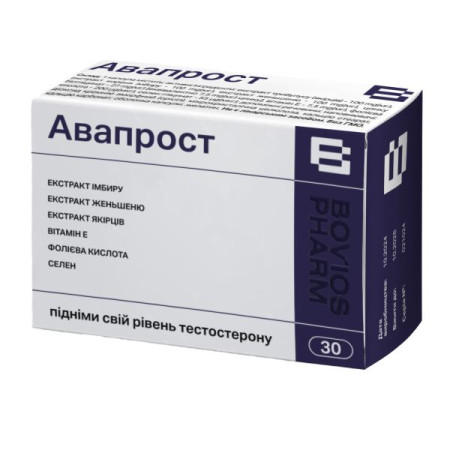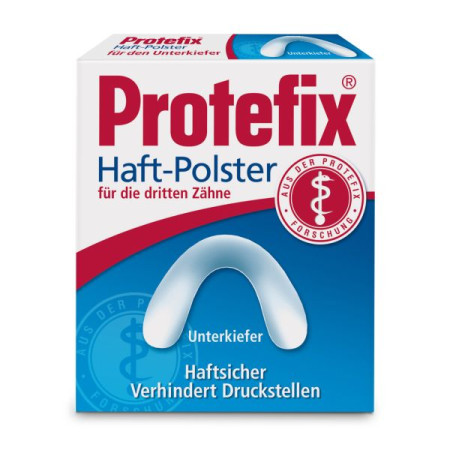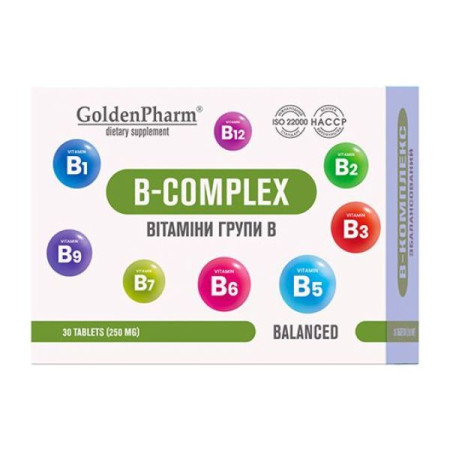Izosol solution for infusions container 500 ml

Instructions for Izosol solution for infusions container 500 ml
Composition
active ingredients: sodium chloride, potassium chloride, calcium chloride dihydrate, magnesium chloride hexahydrate, sodium acetate trihydrate;
100 ml of solution contain: sodium chloride − 0.526 g, potassium chloride − 0.037 g, calcium chloride dihydrate − 0.037 g, magnesium chloride hexahydrate − 0.030 g, sodium acetate trihydrate − 0.680 g;
excipient: water for injections
Dosage form
Solution for infusion.
Main physicochemical properties: clear colorless liquid;
Molar composition, mmol per 1000 ml of the drug: sodium ion – 140.0; potassium ion – 5.0; calcium ion – 2.5; magnesium ion – 1.5; chloride ion – 103.0; acetate ion – 50.0.
Theoretical osmolarity is about 302 mOsmol/L.
Pharmacotherapeutic group
Solutions for intravenous administration. Solutions used to correct electrolyte imbalances. ATX code B05B B01.
Pharmacological properties
Pharmacodynamics. Isosol is a source of water and electrolytes. It can induce diuresis depending on the patient's condition. The drug improves the rheological properties of blood and tissue perfusion, increases the effectiveness of hemotransfusion measures in massive blood loss and severe forms of shock. It also exhibits a detoxification effect due to a short-term increase in fluid volume, a decrease in the concentration of toxic products in the blood with the activation of diuresis.
Sodium, the main cation of extracellular fluid, is involved primarily in the control of water distribution, water balance, and osmotic pressure of body fluids. Sodium is also associated with chlorine and bicarbonate in the regulation of acid-base balance of body fluids.
Potassium, the main cation of intracellular fluid, participates in carbohydrate utilization and protein synthesis, and is needed for the regulation of nerve conduction and muscle contraction, especially of the heart.
Chloride, the major extracellular anion, is closely linked to sodium metabolism, and changes in the body's acid-base balance are reflected by changes in chlorine concentration.
Calcium, an important cation that ensures the formation of bones and teeth (in the form of calcium phosphate and calcium carbonate). In its ionized form, calcium is needed for the functional mechanism of blood clotting, normal heart function, and the regulation of neuromuscular excitability.
Pharmacokinetics.
Na+ and Cl- ions administered with Isosol are subject to the same pharmacokinetics as those administered with food. They are freely distributed in all organs, tissues and intercellular spaces and are excreted by glomerular filtration in the kidneys. In the tubules, significant reabsorption of Na+ and Cl- ions occurs, mainly in the loop of Henle and the distal tubule, including the mechanism of blocking by loop and thiazide diuretics, respectively.
Potassium ions (K+) are freely filtered in the glomerulus, but are almost completely reabsorbed in the proximal tubules, and only 10% of the filtered K+ ions are excreted. Secretion in the distal tubules and collecting ducts can significantly increase K+ elimination. The kidneys have a limited ability to store K+. Therefore, when the concentration in the distal tubules is high, K+ loss can be significant and hypokalemia can develop. This explains the presence of K+ in Isosol.
Calcium ion (Ca2+) homeostasis is well controlled by hormones and rarely requires clinical intervention with intravenous infusion of the solution.
Magnesium ions (Mg2+) are not retained in the vascular bed for long, are quickly distributed throughout all tissues. Magnesium ions are excreted mainly in the urine.
Acetate ions in the body are converted to bicarbonate.
Indication
Hypovolemia and extracellular (isotonic) dehydration due to prolonged vomiting, massive blood loss, diarrhea, significant burns, severe infectious diseases, shock states, inability to orally administer the required daily intake of water and electrolytes. Used to dissolve other compatible concentrated solutions of drugs for parenteral use.
Contraindication
Decompensated heart failure;
extracellular hyperhydration;
hypervolemia;
hypertensive dehydration;
high blood levels of ions that are part of the drug (hyperkalemia, hypernatremia, hypercalcemia);
oliguria and anuria;
acute renal failure;
pulmonary edema, cerebral edema;
hypercoagulation, thrombophlebitis;
metabolic alkalosis;
- treatment with high doses of corticosteroids.
Interaction with other medicinal products and other types of interactions
Increased sodium/potassium retention in the body is possible with the simultaneous use of the following drugs: nonsteroidal anti-inflammatory drugs, androgens, anabolic hormones (steroids), estrogens, corticotropin, mineralocorticoids, vasodilators or ganglioblockers, tacrolimus, cyclosporine, potassium-sparing diuretics, angiotensin-converting enzyme (ACE) inhibitors.
Increased urinary alkalinity due to the formation of bicarbonate ion as a result of acetate metabolism enhances the excretion of some drugs (such as quinidine, salicylates, lithium) and reduces the excretion of sympathomimetics (such as amphetamine).
When used in combination with cardiac glycosides, the likelihood of their toxic effects increases.
Application features
Patients with cardiac or pulmonary failure, edema, renal failure, cirrhosis of the liver accompanied by ascites should use large volumes of infusion with extreme caution.
During prolonged parenteral therapy, laboratory parameters should be determined and the patient's clinical condition assessed every 6 hours (depending on the infusion rate) to monitor electrolyte concentrations and water-electrolyte balance.
The use of intravenous solutions may cause fluid and/or solute overload, hyperhydration, congestion, and pulmonary edema. The risk of dilution is inversely proportional to electrolyte concentration. The risk of fluid overload, which causes congestion with peripheral edema and pulmonary edema, is directly proportional to electrolyte concentration.
Due to the content of sodium ions, the solution should be used with caution in patients with renal and cardiovascular insufficiency, with congestive heart failure, especially in the postoperative period, in elderly patients, as well as in patients with clinical conditions accompanied by sodium retention and edema, peripheral or pulmonary edema, hypertension, preeclampsia, aldosteronism or other clinical conditions accompanied by sodium retention in the body.
Sodium-containing solutions should be used with caution in patients receiving corticosteroids or corticotropin.
Since the drug contains potassium, caution is required when using the solution in patients with heart disease, severe renal insufficiency, or conditions that may lead to hyperkalemia (e.g., renal or adrenocortical insufficiency, acute dehydration, or extensive tissue destruction, as occurs with severe burns).
The drug contains potassium in a concentration close to its concentration in plasma, but it should not be used to eliminate potassium deficiency in case of severe hypokalemia.
Since the drug contains calcium ions, its use should be carried out under the control of cardiac activity using an ECG, especially in patients receiving cardiac glycosides (e.g. digitalis). Serum calcium levels do not always reflect tissue calcium levels. In patients with reduced renal excretory function, the administration of the solution may lead to sodium or potassium retention. Caution is also required in the case of simultaneous administration with blood preparations due to the likelihood of coagulation. The drug should be used with caution in patients with diseases associated with elevated vitamin D concentrations, such as sarcoidosis.
Since the drug contains magnesium ions, caution is required when using the solution in patients with impaired renal function, cardiac disorders and patients with myasthenia gravis. Patients should be monitored for clinical conditions with signs of hypermagnesemia, especially in the treatment of eclampsia.
The drug should be used with caution in the postoperative period in the case of neuromuscular blockade, since magnesium salts may lead to a relapse effect.
The use of the drug may cause metabolic alkalosis due to the presence of acetate ions, however, the drug is not used to treat severe metabolic or respiratory acidosis.
During treatment with parenteral Isosol, it is necessary to ensure adequate nutrition of the patient.
This solution is intended for intravenous administration using sterile equipment. It is recommended to change the intravenous line at least every 24 hours.
The solution should only be used when it is clear and the bottle is airtight.
The doctor should also consider the possibility of developing adverse reactions to drugs used concurrently with Isosol.
If an adverse reaction occurs, the infusion should be stopped, the patient's condition assessed, and appropriate therapeutic measures instituted.
Use during pregnancy or breastfeeding
Studies on the use of the drug in pregnant women have not been conducted. It is not known whether this drug is excreted in human milk. Since most drugs are excreted in human milk, caution should be exercised when prescribing the drug during lactation.
Ability to influence reaction speed when driving vehicles or other mechanisms
During treatment, caution should be exercised when driving vehicles and operating other mechanisms.
Method of administration and doses
The solution is intended for intravenous use only.
Typically, the infusion volume for an adult is 210 ml/hour (with a body weight of 70 kg) or 3 ml/kg body weight/hour. The infusion rate for adults is 70 drops/minute. The maximum daily volume is 30 ml/kg body weight and depends on the state of water and electrolyte balance, cardiovascular system and renal function.
The volume of solution should be determined by calculating the patient's fluid requirements.
Parenteral products should be inspected visually for visible foreign particles and discoloration prior to administration.
Children.
Do not use on children.
Overdose
Administration of too much solution may lead to fluid and electrolyte imbalance (hypervolemia, hypernatremia, hypercalcemia, hyperchloremia) and acid-base imbalance; venous stasis, edema (including pulmonary or cerebral edema), hyperhydration characterized by excessive skin tension; increased plasma osmolarity.
Treatment. In case of development of the specified conditions it is necessary to stop administration of drug. In case of phenomena of hyperhydration appoint diuretics or laxatives, in case of hypervolemia – apply method of extrarenal purification, in case of simultaneous manifestations of extracellular hyperhydration with intracellular dehydration, and also in case of hypernatremia apply 5% glucose solution.
Side effects
Immune system disorders: hypersensitivity reactions, allergic reactions or anaphylaxis/anaphylactoid symptoms.
Metabolic disorders: electrolyte imbalance (potassium, calcium, sodium, chlorine), chloride acidosis, hyperhydration.
Nervous system: seizure provoked by alkalosis induced by the presence of acetate.
Cardiac: heart failure in patients with cardiac disorders; tachycardia, bradycardia.
Respiratory, thoracic and mediastinal disorders: pulmonary edema.
General disorders and administration site conditions: chest tightness or pain; febrile reaction (fever), infection or pain at the injection site, feeling unwell, vein irritation, venous thrombosis or phlebitis starting at the injection site, accidental injection of the drug under the skin.
Skin and subcutaneous tissue disorders: local or generalized urticaria (skin rash, erythema, itching).
Adverse reactions may be associated with drugs for which Isosol was used as a solvent.
In case of undesirable manifestations, adverse reactions or in case of lack of therapeutic effect, it is necessary to report to the address: 85 Sambirska St., Drohobych, Lviv region, Ukraine, 82111, tel. (03244) 3-99-94, fax. (03244) 2-40-27, e-mail address pharmatrade@mail.lviv.ua, 24-hour tel. +38 (068) 302-50-85.
Expiration date
2 years.
Storage conditions
Store at a temperature not exceeding 25 ° C. Do not freeze.
Keep out of reach of children.
Incompatibility
Before using Izosol, its compatibility with other drugs that will be used simultaneously should be assessed. Izosol should not be mixed with drugs containing carbonates, sulfates and phosphates. It is also not recommended to mix Izosol with other drugs if there are no compatibility studies. Before adding any drug to Izosol, it is necessary to make sure that the drug is soluble and stable in water at the pH of Izosol (6.6 - 7.4).
To reduce the risk of possible incompatibility arising when mixing this solution with other drugs, the final infusion solution should be inspected for turbidity or precipitation.
Packaging
100 ml, or 200 ml, or 250 ml, or 400 ml, or 500 ml in a container; 1 container in a cardboard box.
Vacation category
According to the recipe.
Producer
Subsidiary company "Pharmatrade".
Address
Ukraine, 82111, Lviv region, Drohobych, Sambirska st., 85
Applicant
Subsidiary company "Pharmatrade".
There are no reviews for this product.
There are no reviews for this product, be the first to leave your review.
No questions about this product, be the first and ask your question.








